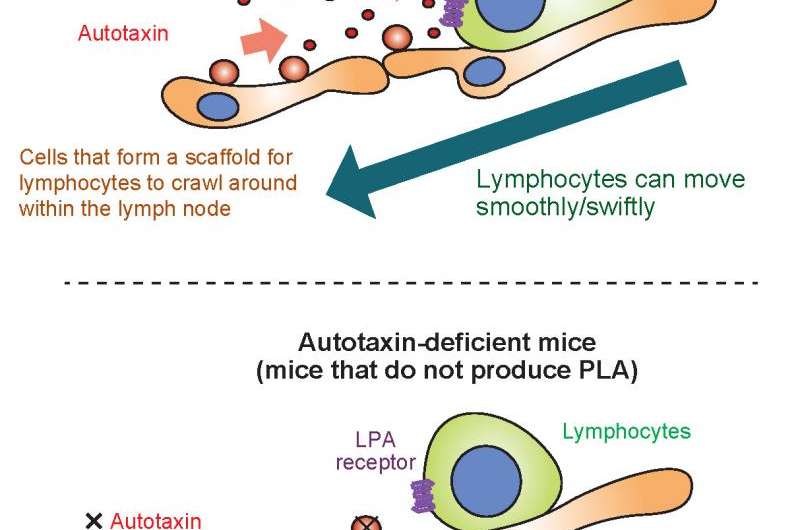Lipid helps lymphocytes patrol

The mechanism of efficient lymphocyte motility within lymphoid tissues has remained unknown. A research group led by Osaka University and the University of Turku has found for the first time that a lipid called lysophosphatidic acid (LPA) plays a vital role in regulating lymphocyte motility within lymph nodes. Targeting LPA and its receptors may provide novel strategies to control immune responses.
Lymphocytes serve as patrolling police officers of the body. They look for invading pathogens and abnormal cells (that may arise any time in our body) by patrolling continuously throughout the body by way of the blood vessels and lymphatics. On their way, they always enter lymph nodes to look for such invaders, because the lymph node is a place where foreign antigens wander in from peripheral tissues. Once lymphocytes find such invaders within the lymph node, they destroy them in collaboration with other types of immune cells. Thus, lymph nodes are not only a garrison for immune cells but also a battle ground where fighting between our immune cells and invaders takes place. So, lymphocytes are expected to move around swiftly within lymph nodes so as to confront the invaders effectively, but how they realize this has been unclear.
A group of people at Osaka University (Eiji Umemoto [Associate Professor, Laboratory of Immune Regulation, Osaka University Graduate School of Medicine] and Masayuki Miyasaka [Specially Appointed Professor, Institute for Academic Initiatives]) and University of Turku, Finland (Akira Takeda, Postdoctoral researcher at MediCity Research Laboratory) has found for the first time that a lipid called lysophosphatidic acid (LPA) plays a vital role in regulating lymphocyte motility within lymph nodes. LPA is produced by a specific type of stromal cells, which forms a scaffold for lymphocytes to crawl around within the node. LPA in turn acts on lymphocytes via a specific receptor (LPA2), enabling them to move around efficiently through the narrow spaces in lymph nodes, which are normally jammed with immune cells and stromal cells.
This work is expected to lead to development of novel strategies to control immune responses. Given also that LPA's precursors are abundant in cabbages and soybeans and that LPA itself is contained in some herbal medicines, this discovery is interesting from the viewpoint of healthy diet and the human wellness.
The present work was published in the February 2 issue of a British open-access journal eLife that publishes outstanding researches in the life sciences and biomedicine.
More information: Akira Takeda et al. Fibroblastic reticular cell-derived lysophosphatidic acid regulates confined intranodal T-cell motility, eLife (2016). DOI: 10.7554/eLife.10561



















